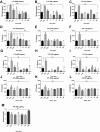Potential toxicity of polystyrene microplastic particles
- PMID: 32355311
- PMCID: PMC7193629
- DOI: 10.1038/s41598-020-64464-9
Potential toxicity of polystyrene microplastic particles
Abstract
Environmental pollution arising from plastic waste is a major global concern. Plastic macroparticles, microparticles, and nanoparticles have the potential to affect marine ecosystems and human health. It is generally accepted that microplastic particles are not harmful or at best minimal to human health. However direct contact with microplastic particles may have possible adverse effect in cellular level. Primary polystyrene (PS) particles were the focus of this study, and we investigated the potential impacts of these microplastics on human health at the cellular level. We determined that PS particles were potential immune stimulants that induced cytokine and chemokine production in a size-dependent and concentration-dependent manner.
Conflict of interest statement
The authors declare no competing interests.
Figures






References
-
- Dauvergne P. The power of environmental norms: marine plastic pollution and the politics of microbeads. Environmental Politics. 2018;27:579–597. doi: 10.1080/09644016.2018.1449090. - DOI
-
- Gregory MR. Plastic ‘scrubbers’ in hand cleansers: a further (and minor) source for marine pollution identified. Marine pollution bulletin. 1996;32:867–871. doi: 10.1016/S0025-326X(96)00047-1. - DOI
Publication types
LinkOut - more resources
Full Text Sources

